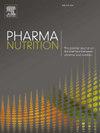Mechanism of Epigallocatechin-3-gallate in the prevention and treatment of irritable bowel syndrome: A network pharmacology and gene expression omnibus chip data-based study
IF 2.4
Q3 NUTRITION & DIETETICS
引用次数: 0
Abstract
Irritable bowel syndrome (IBS) is the most common functional gastrointestinal disorder, characterized by abdominal pain, bloating, and changes in bowel habits. Green tea has been reported to possess anti-inflammatory and antioxidant properties, which may aid in improving intestinal inflammation. However, the targets and mechanisms of green tea in treating IBS are still unclear. In this study, we utilized network pharmacology and molecular docking techniques in combination with Gene Expression Omnibus (GEO) chip analysis and bioinformatics analysis. Our aim was to explore the molecular targets and mechanisms of Epigallocatechin-3-gallate (EGCG), the primary active component found in green tea, for the prevention and treatment of IBS. We obtained 164 drug targets, 335 differentially expressed genes of IBS, and 12 drug-disease cross genes. After screening the results, TNF, TLR4, PTGS2, and IL10 were identified as core targets. Molecular docking results confirmed that EGCG binds to these core targets and can be used for the prevention and treatment of IBS. Then, we stimulated M1-type macrophages with EGCG and showed that EGCG up-regulated mRNA of IL10 and down-regulated mRNA of TNF and TLR4 in macrophages. This study suggests that EGCG may be involved in inflammation-related signaling pathways and plays a key role in the prevention and treatment of IBS by acting on disease targets such as TNF, TLR4, PTGS2, and IL10.
表没食子儿茶素-3-没食子酸酯预防和治疗肠易激综合征的机制:基于网络药理学和基因表达综合芯片数据的研究
肠易激综合征(IBS)是最常见的功能性胃肠道疾病,其特征是腹痛、腹胀和排便习惯的改变。据报道,绿茶具有抗炎和抗氧化的特性,这可能有助于改善肠道炎症。然而,绿茶治疗肠易激综合征的靶点和机制尚不清楚。在本研究中,我们利用网络药理学和分子对接技术,结合Gene Expression Omnibus (GEO)芯片分析和生物信息学分析。我们的目的是探索绿茶中主要活性成分表没食子儿茶素-3-没食子酸酯(EGCG)预防和治疗肠易激综合征的分子靶点和机制。我们获得164个药物靶点,335个IBS差异表达基因和12个药病交叉基因。筛选结果后,TNF、TLR4、PTGS2和IL10被确定为核心靶点。分子对接结果证实EGCG与这些核心靶点结合,可用于IBS的预防和治疗。然后,我们用EGCG刺激m1型巨噬细胞,发现EGCG上调巨噬细胞中IL10的mRNA,下调TNF和TLR4的mRNA。本研究提示EGCG可能参与炎症相关信号通路,通过作用于肿瘤坏死因子(TNF)、TLR4、PTGS2、IL10等疾病靶点,在IBS的预防和治疗中发挥关键作用。
本文章由计算机程序翻译,如有差异,请以英文原文为准。
求助全文
约1分钟内获得全文
求助全文
来源期刊

PharmaNutrition
Agricultural and Biological Sciences-Food Science
CiteScore
5.70
自引率
3.10%
发文量
33
审稿时长
12 days
 求助内容:
求助内容: 应助结果提醒方式:
应助结果提醒方式:


